Abstract
Glycerophosphoinositols are phosphoinositide metabolites whose levels are constitutively elevated in Ras-transformed cells. Here, we show that one of these compounds, glycerophosphoinositol-4-phosphate (GroPIns-4-P) responds acutely to the stimulation of the epidermal growth factor receptor, with a fast, massive and transient increase. The mechanism leading to GroPIns-4-P formation involves the activation of phosphoinositide-3 kinase and the small GTP-binding protein Rac, since GroPIns-4-P was neither formed in cells expressing the dominant negative form of Rac nor in cells treated with the phosphoinositide-3 kinase inhibitor wortmannin. GroPIns-4-P has been previously shown to inhibit adenylyl cyclase. Accordingly, epidermal growth factor also decreased the basal, cholera toxin-stimulated, and forskolin-stimulated cyclic AMP levels with kinetics similar to those of GroPIns-4-P formation, suggesting that GroPIns-4-P mediates this inhibitory effect. The hormone-induced formation of GroPIns-4-P was detected in several cell lines of various origin, suggesting that GroPIns-4-P is a novel intracellular messenger of the Ras pathway, possibly able to convey information from tyrosine kinase receptors to the cyclic AMP cascade.
Full text
PDF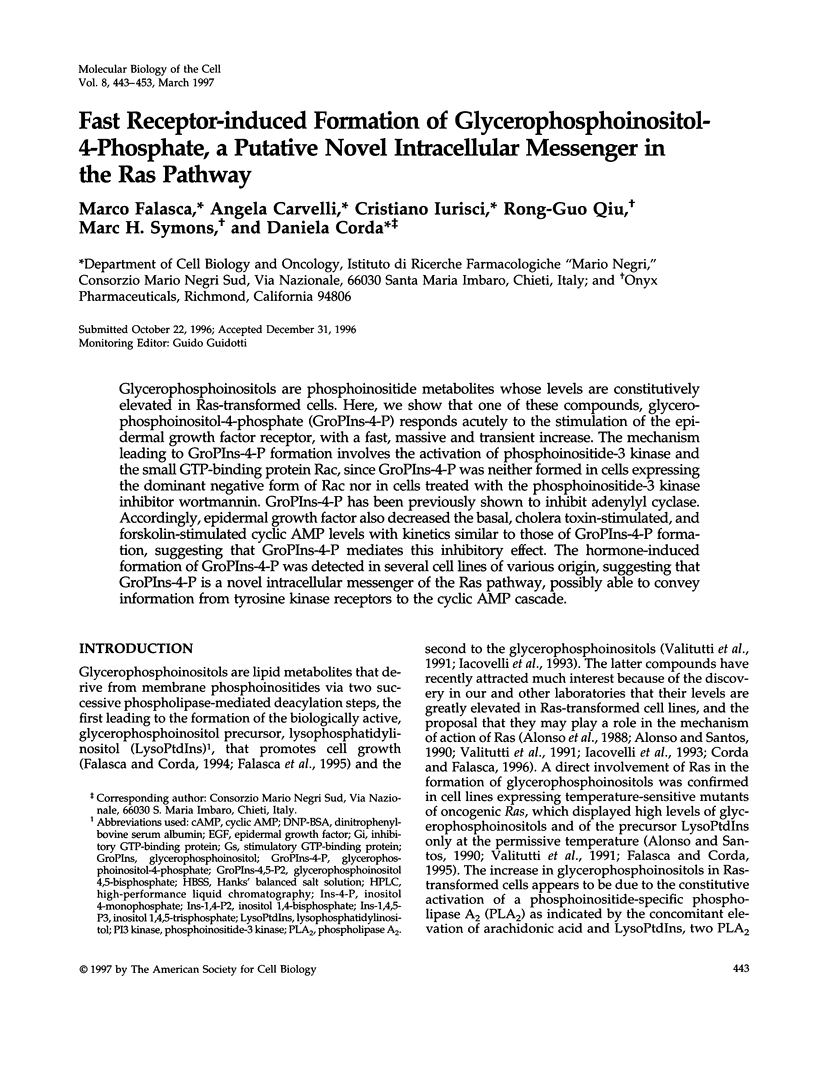
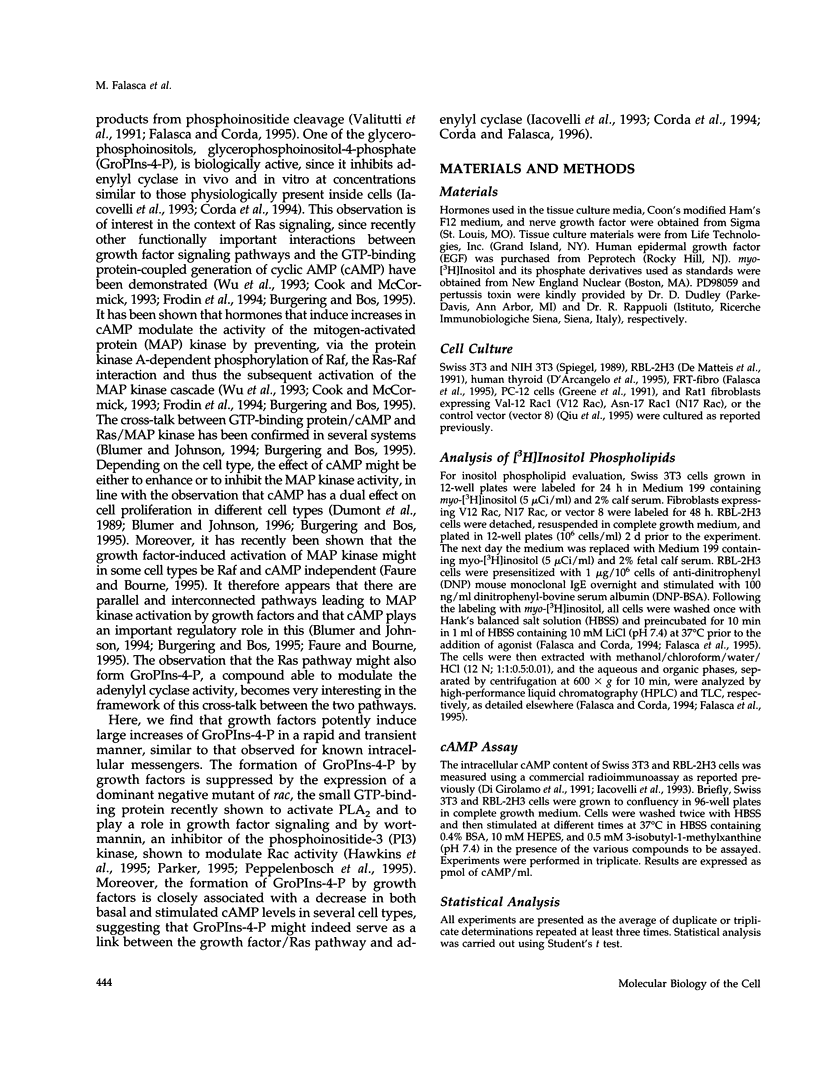
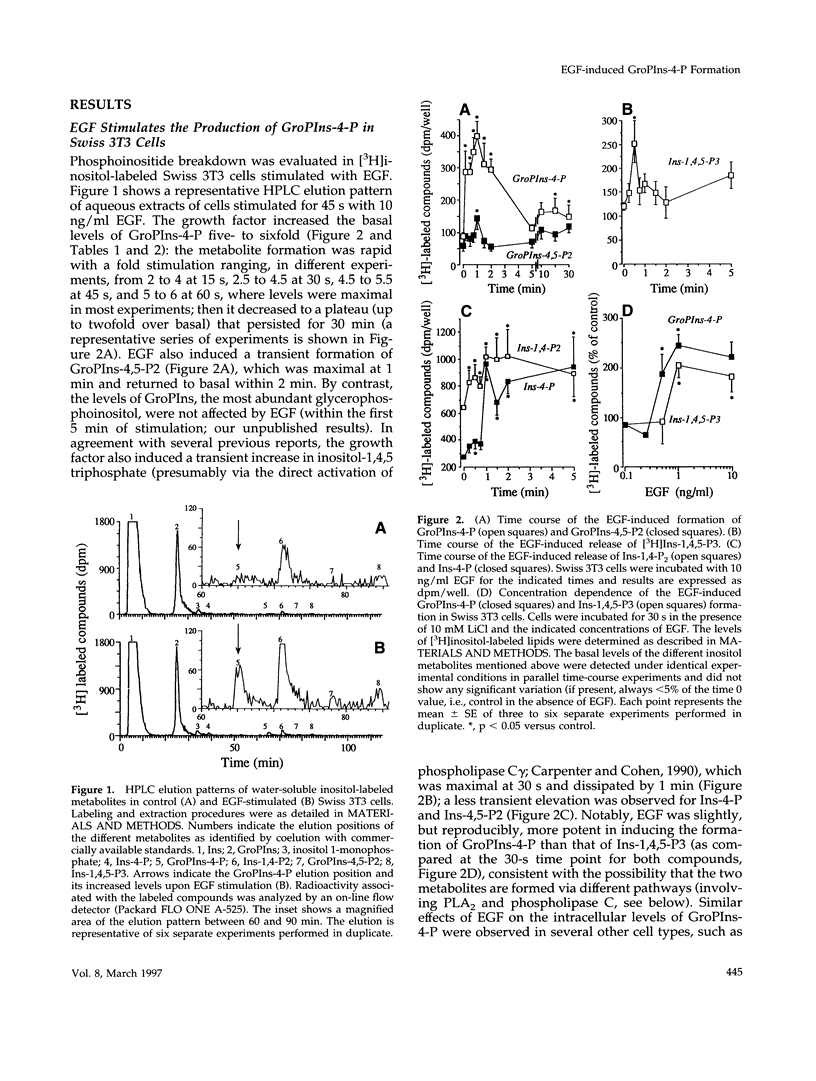
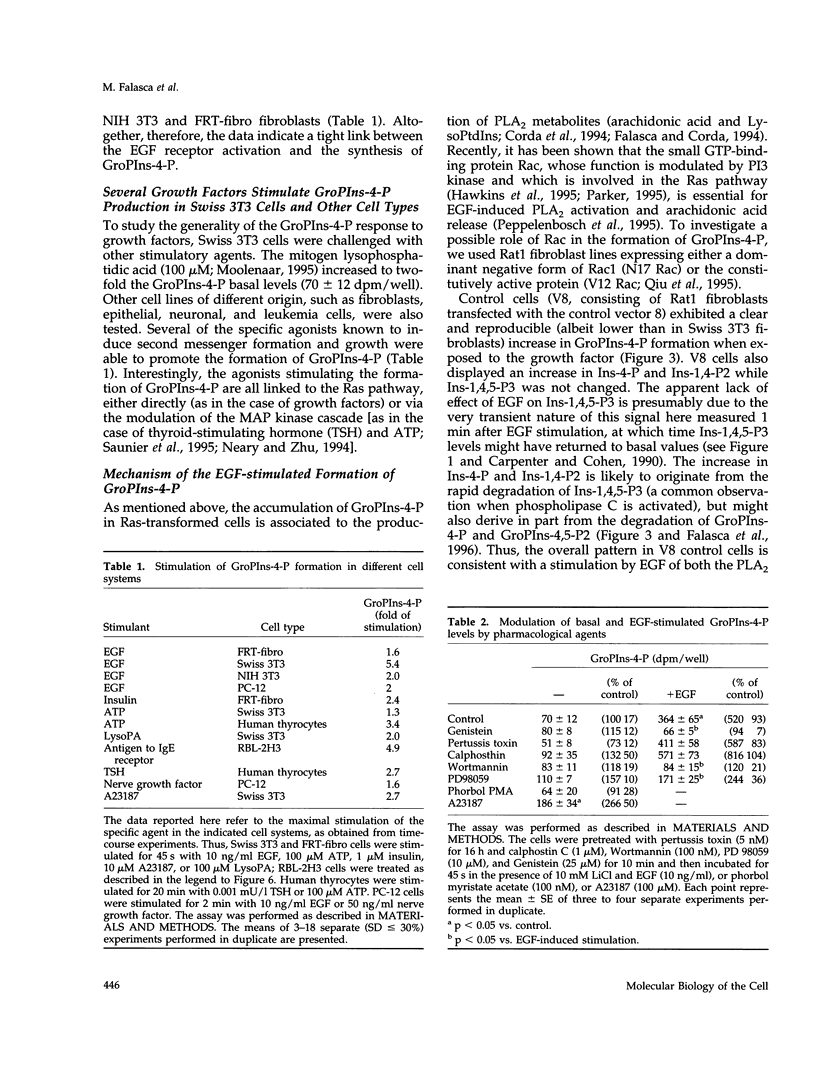
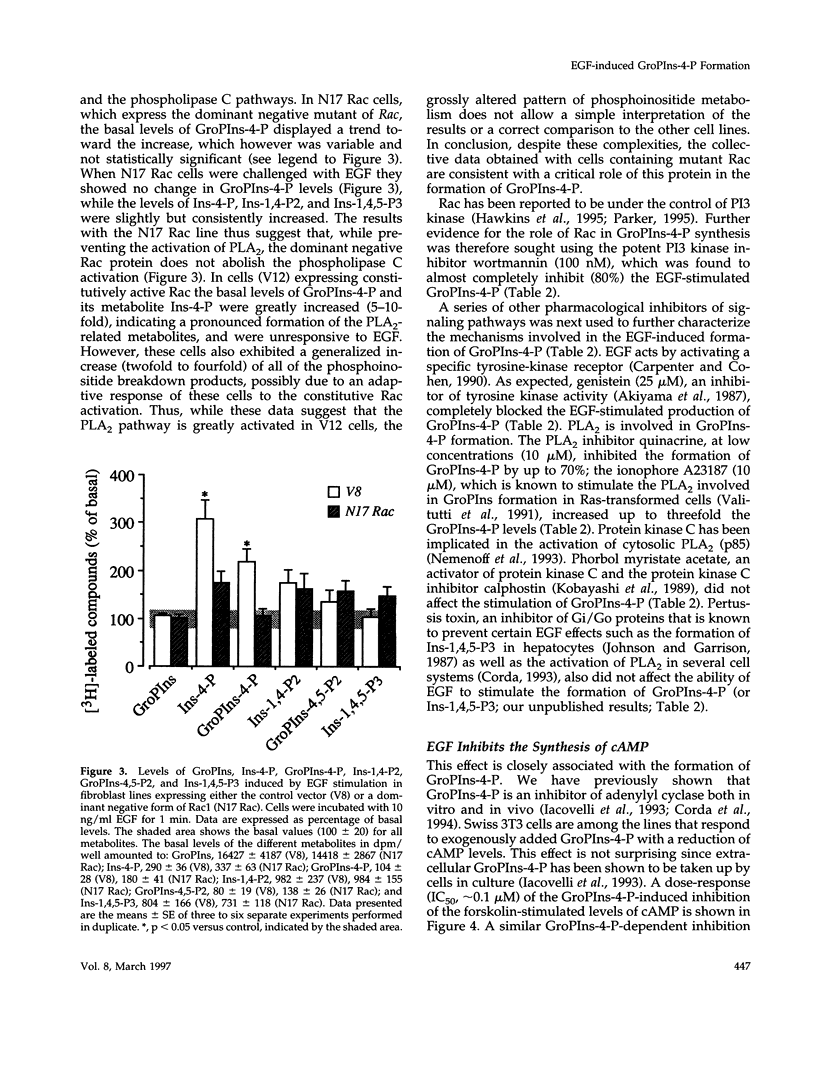
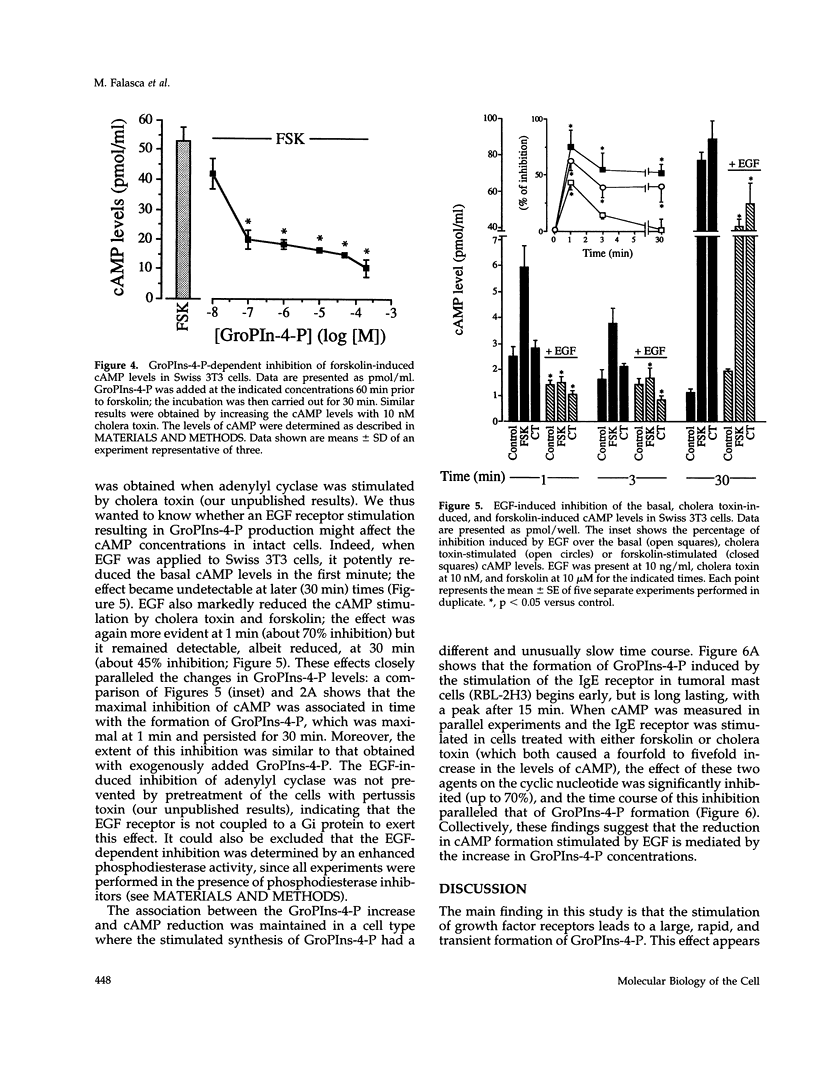
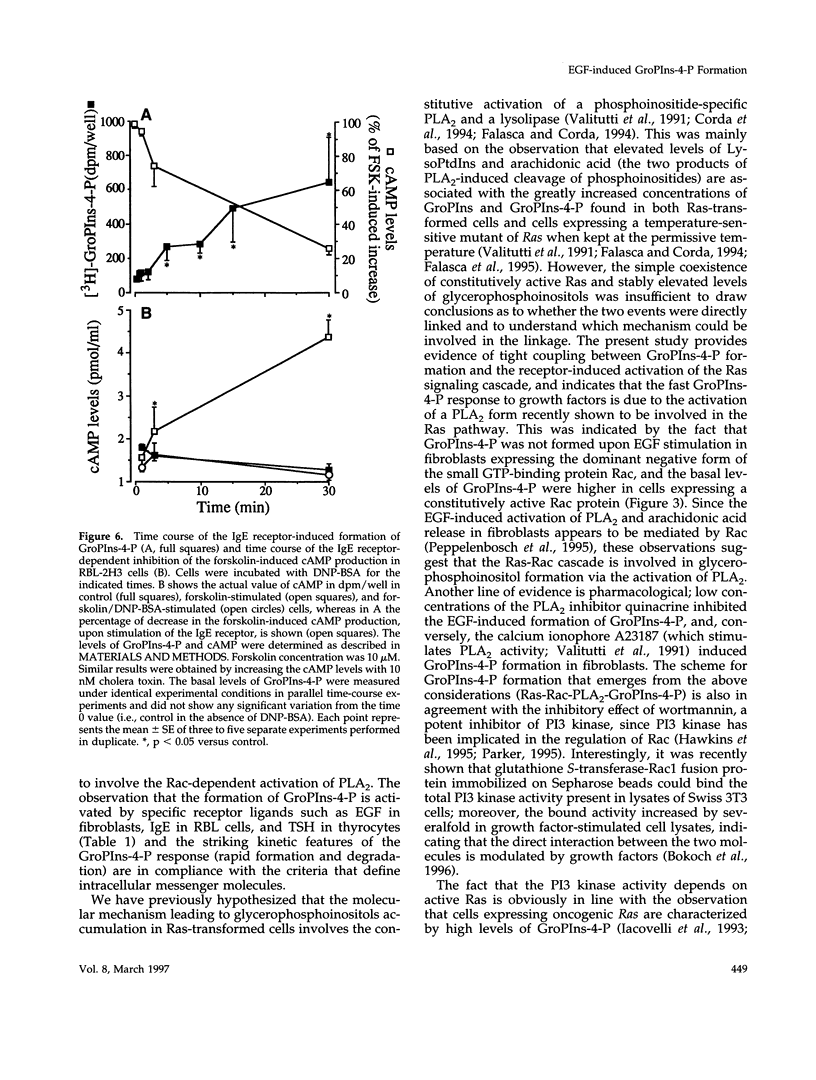
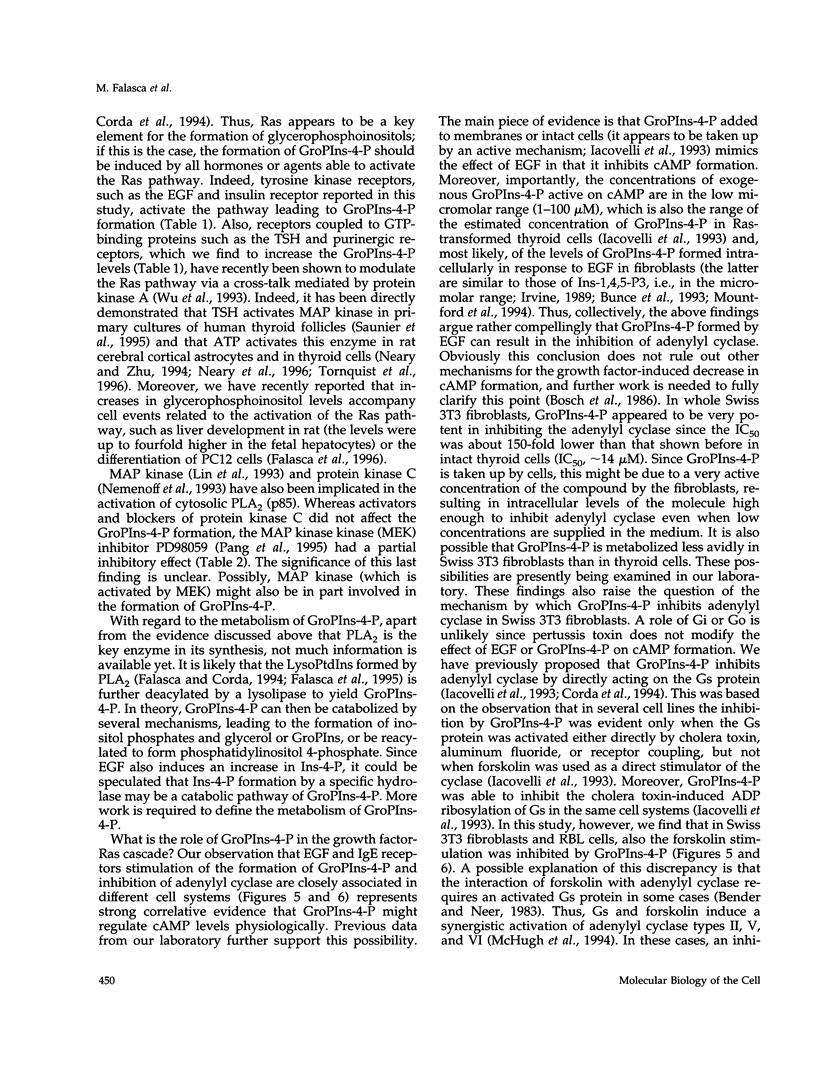
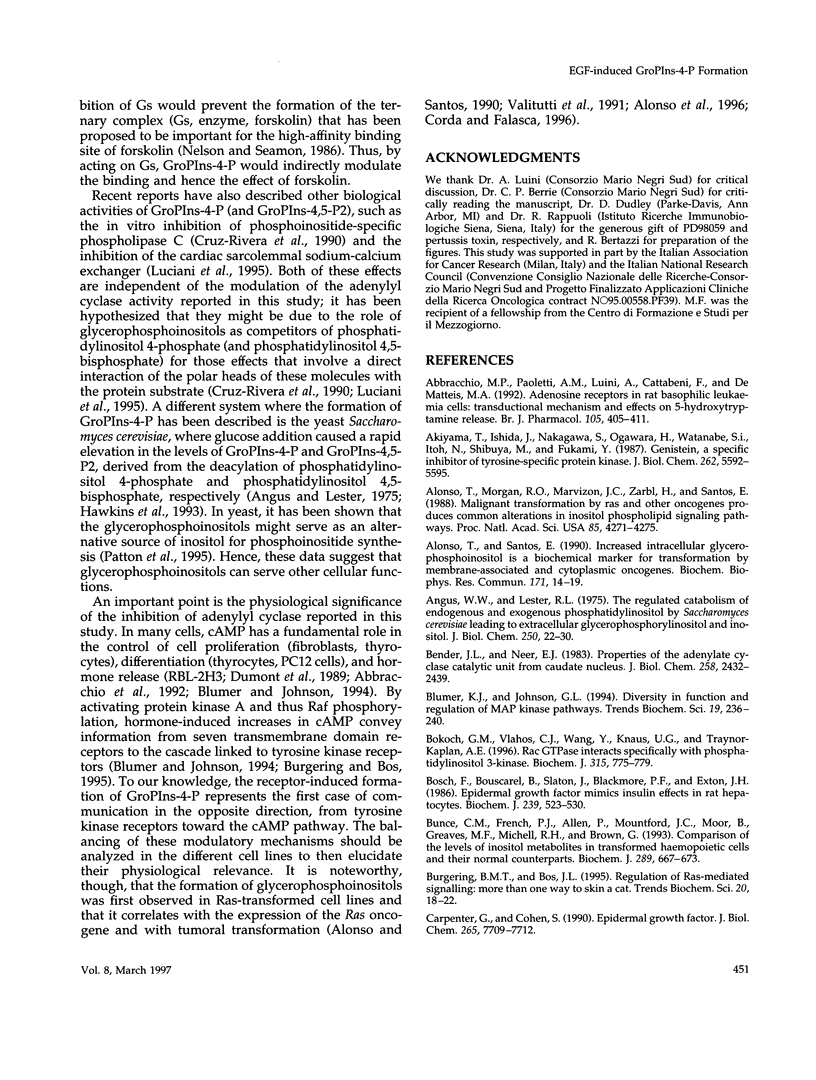
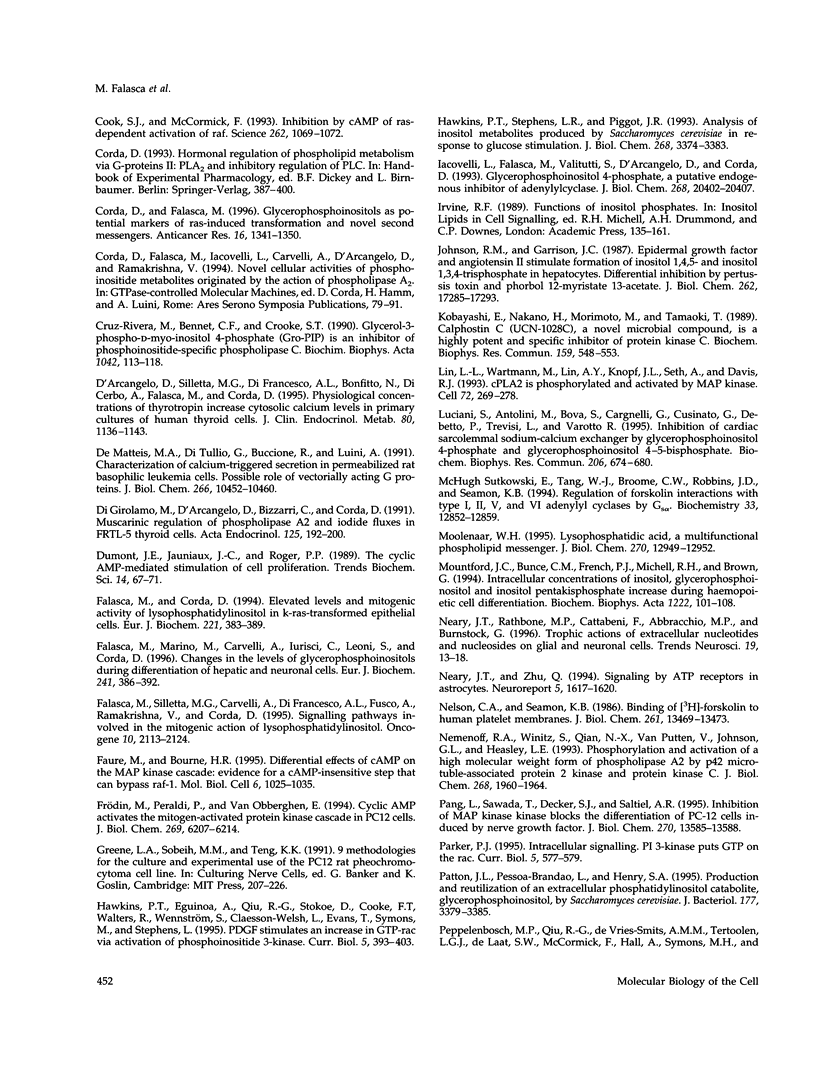

Selected References
These references are in PubMed. This may not be the complete list of references from this article.
- Abbracchio M. P., Paoletti A. M., Luini A., Cattabeni F., De Matteis M. A. Adenosine receptors in rat basophilic leukaemia cells: transductional mechanisms and effects on 5-hydroxytryptamine release. Br J Pharmacol. 1992 Feb;105(2):405–411. doi: 10.1111/j.1476-5381.1992.tb14266.x. [DOI] [PMC free article] [PubMed] [Google Scholar]
- Akiyama T., Ishida J., Nakagawa S., Ogawara H., Watanabe S., Itoh N., Shibuya M., Fukami Y. Genistein, a specific inhibitor of tyrosine-specific protein kinases. J Biol Chem. 1987 Apr 25;262(12):5592–5595. [PubMed] [Google Scholar]
- Alonso T., Morgan R. O., Marvizon J. C., Zarbl H., Santos E. Malignant transformation by ras and other oncogenes produces common alterations in inositol phospholipid signaling pathways. Proc Natl Acad Sci U S A. 1988 Jun;85(12):4271–4275. doi: 10.1073/pnas.85.12.4271. [DOI] [PMC free article] [PubMed] [Google Scholar]
- Alonso T., Santos E. Increased intracellular glycerophosphoinositol is a biochemical marker for transformation by membrane-associated and cytoplasmic oncogenes. Biochem Biophys Res Commun. 1990 Aug 31;171(1):14–19. doi: 10.1016/0006-291x(90)91349-w. [DOI] [PubMed] [Google Scholar]
- Angus W. W., Lester R. L. The regulated catabolism of endogenous and exogenous phosphatidylinositol by Saccharomyces cerevisiae leading to extracellular glycerophosphorylinositol and inositol. J Biol Chem. 1975 Jan 10;250(1):22–30. [PubMed] [Google Scholar]
- Bender J. L., Neer E. J. Properties of the adenylate cyclase catalytic unit from caudate nucleus. J Biol Chem. 1983 Feb 25;258(4):2432–2439. [PubMed] [Google Scholar]
- Blumer K. J., Johnson G. L. Diversity in function and regulation of MAP kinase pathways. Trends Biochem Sci. 1994 Jun;19(6):236–240. doi: 10.1016/0968-0004(94)90147-3. [DOI] [PubMed] [Google Scholar]
- Bokoch G. M., Vlahos C. J., Wang Y., Knaus U. G., Traynor-Kaplan A. E. Rac GTPase interacts specifically with phosphatidylinositol 3-kinase. Biochem J. 1996 May 1;315(Pt 3):775–779. doi: 10.1042/bj3150775. [DOI] [PMC free article] [PubMed] [Google Scholar]
- Bosch F., Bouscarel B., Slaton J., Blackmore P. F., Exton J. H. Epidermal growth factor mimics insulin effects in rat hepatocytes. Biochem J. 1986 Nov 1;239(3):523–530. doi: 10.1042/bj2390523. [DOI] [PMC free article] [PubMed] [Google Scholar]
- Bunce C. M., French P. J., Allen P., Mountford J. C., Moor B., Greaves M. F., Michell R. H., Brown G. Comparison of the levels of inositol metabolites in transformed haemopoietic cells and their normal counterparts. Biochem J. 1993 Feb 1;289(Pt 3):667–673. doi: 10.1042/bj2890667. [DOI] [PMC free article] [PubMed] [Google Scholar]
- Burgering B. M., Bos J. L. Regulation of Ras-mediated signalling: more than one way to skin a cat. Trends Biochem Sci. 1995 Jan;20(1):18–22. doi: 10.1016/s0968-0004(00)88944-6. [DOI] [PubMed] [Google Scholar]
- Carpenter G., Cohen S. Epidermal growth factor. J Biol Chem. 1990 May 15;265(14):7709–7712. [PubMed] [Google Scholar]
- Cook S. J., McCormick F. Inhibition by cAMP of Ras-dependent activation of Raf. Science. 1993 Nov 12;262(5136):1069–1072. doi: 10.1126/science.7694367. [DOI] [PubMed] [Google Scholar]
- Corda D., Falasca M. Glycerophosphoinositols as potential markers of ras-induced transformation and novel second messengers. Anticancer Res. 1996 May-Jun;16(3B):1341–1350. [PubMed] [Google Scholar]
- Cruz-Rivera M., Bennett C. F., Crooke S. T. Glycerol-3-phospho-D-myo-inositol 4-phosphate (Gro-PIP) is an inhibitor of phosphoinositide-specific phospholipase C. Biochim Biophys Acta. 1990 Jan 16;1042(1):113–118. doi: 10.1016/0005-2760(90)90064-5. [DOI] [PubMed] [Google Scholar]
- D'Arcangelo D., Silletta M. G., Di Francesco A. L., Bonfitto N., Di Cerbo A., Falasca M., Corda D. Physiological concentrations of thyrotropin increase cytosolic calcium levels in primary cultures of human thyroid cells. J Clin Endocrinol Metab. 1995 Apr;80(4):1136–1143. doi: 10.1210/jcem.80.4.7714082. [DOI] [PubMed] [Google Scholar]
- De Matteis M. A., Di Tullio G., Buccione R., Luini A. Characterization of calcium-triggered secretion in permeabilized rat basophilic leukemia cells. Possible role of vectorially acting G proteins. J Biol Chem. 1991 Jun 5;266(16):10452–10460. [PubMed] [Google Scholar]
- Di Girolamo M., D'Arcangelo D., Bizzarri C., Corda D. Muscarinic regulation of phospholipase A2 and iodide fluxes in FRTL-5 thyroid cells. Acta Endocrinol (Copenh) 1991 Aug;125(2):192–200. doi: 10.1530/acta.0.1250192. [DOI] [PubMed] [Google Scholar]
- Dumont J. E., Jauniaux J. C., Roger P. P. The cyclic AMP-mediated stimulation of cell proliferation. Trends Biochem Sci. 1989 Feb;14(2):67–71. doi: 10.1016/0968-0004(89)90046-7. [DOI] [PubMed] [Google Scholar]
- Falasca M., Corda D. Elevated levels and mitogenic activity of lysophosphatidylinositol in k-ras-transformed epithelial cells. Eur J Biochem. 1994 Apr 1;221(1):383–389. doi: 10.1111/j.1432-1033.1994.tb18750.x. [DOI] [PubMed] [Google Scholar]
- Falasca M., Marino M., Carvelli A., Iurisci C., Leoni S., Corda D. Changes in the levels of glycerophosphoinositols during differentiation of hepatic and neuronal cells. Eur J Biochem. 1996 Oct 15;241(2):386–392. doi: 10.1111/j.1432-1033.1996.00386.x. [DOI] [PubMed] [Google Scholar]
- Falasca M., Silletta M. G., Carvelli A., Di Francesco A. L., Fusco A., Ramakrishna V., Corda D. Signalling pathways involved in the mitogenic action of lysophosphatidylinositol. Oncogene. 1995 Jun 1;10(11):2113–2124. [PubMed] [Google Scholar]
- Faure M., Bourne H. R. Differential effects on cAMP on the MAP kinase cascade: evidence for a cAMP-insensitive step that can bypass Raf-1. Mol Biol Cell. 1995 Aug;6(8):1025–1035. doi: 10.1091/mbc.6.8.1025. [DOI] [PMC free article] [PubMed] [Google Scholar]
- Frödin M., Peraldi P., Van Obberghen E. Cyclic AMP activates the mitogen-activated protein kinase cascade in PC12 cells. J Biol Chem. 1994 Feb 25;269(8):6207–6214. [PubMed] [Google Scholar]
- Hawkins P. T., Eguinoa A., Qiu R. G., Stokoe D., Cooke F. T., Walters R., Wennström S., Claesson-Welsh L., Evans T., Symons M. PDGF stimulates an increase in GTP-Rac via activation of phosphoinositide 3-kinase. Curr Biol. 1995 Apr 1;5(4):393–403. doi: 10.1016/s0960-9822(95)00080-7. [DOI] [PubMed] [Google Scholar]
- Hawkins P. T., Stephens L. R., Piggott J. R. Analysis of inositol metabolites produced by Saccharomyces cerevisiae in response to glucose stimulation. J Biol Chem. 1993 Feb 15;268(5):3374–3383. [PubMed] [Google Scholar]
- Iacovelli L., Falasca M., Valitutti S., D'Arcangelo D., Corda D. Glycerophosphoinositol 4-phosphate, a putative endogenous inhibitor of adenylylcyclase. J Biol Chem. 1993 Sep 25;268(27):20402–20407. [PubMed] [Google Scholar]
- Johnson R. M., Garrison J. C. Epidermal growth factor and angiotensin II stimulate formation of inositol 1,4,5- and inositol 1,3,4-trisphosphate in hepatocytes. Differential inhibition by pertussis toxin and phorbol 12-myristate 13-acetate. J Biol Chem. 1987 Dec 25;262(36):17285–17293. [PubMed] [Google Scholar]
- Kobayashi E., Nakano H., Morimoto M., Tamaoki T. Calphostin C (UCN-1028C), a novel microbial compound, is a highly potent and specific inhibitor of protein kinase C. Biochem Biophys Res Commun. 1989 Mar 15;159(2):548–553. doi: 10.1016/0006-291x(89)90028-4. [DOI] [PubMed] [Google Scholar]
- Lin L. L., Wartmann M., Lin A. Y., Knopf J. L., Seth A., Davis R. J. cPLA2 is phosphorylated and activated by MAP kinase. Cell. 1993 Jan 29;72(2):269–278. doi: 10.1016/0092-8674(93)90666-e. [DOI] [PubMed] [Google Scholar]
- Luciani S., Antolini M., Bova S., Cargnelli G., Cusinato F., Debetto P., Trevisi L., Varotto R. Inhibition of cardiac sarcolemmal sodium-calcium exchanger by glycerophosphoinositol 4-phosphate and glycerophosphoinositol 4-5-bisphosphate. Biochem Biophys Res Commun. 1995 Jan 17;206(2):674–680. doi: 10.1006/bbrc.1995.1095. [DOI] [PubMed] [Google Scholar]
- Moolenaar W. H. Lysophosphatidic acid, a multifunctional phospholipid messenger. J Biol Chem. 1995 Jun 2;270(22):12949–12952. doi: 10.1074/jbc.270.22.12949. [DOI] [PubMed] [Google Scholar]
- Mountford J. C., Bunce C. M., French P. J., Michell R. H., Brown G. Intracellular concentrations of inositol, glycerophosphoinositol and inositol pentakisphosphate increase during haemopoietic cell differentiation. Biochim Biophys Acta. 1994 May 26;1222(1):101–108. doi: 10.1016/0167-4889(94)90030-2. [DOI] [PubMed] [Google Scholar]
- Neary J. T., Rathbone M. P., Cattabeni F., Abbracchio M. P., Burnstock G. Trophic actions of extracellular nucleotides and nucleosides on glial and neuronal cells. Trends Neurosci. 1996 Jan;19(1):13–18. doi: 10.1016/0166-2236(96)81861-3. [DOI] [PubMed] [Google Scholar]
- Neary J. T., Zhu Q. Signaling by ATP receptors in astrocytes. Neuroreport. 1994 Aug 15;5(13):1617–1620. doi: 10.1097/00001756-199408150-00019. [DOI] [PubMed] [Google Scholar]
- Nelson C. A., Seamon K. B. Binding of [3H]forskolin to human platelet membranes. Regulation by guanyl-5'-yl imidodiphosphate, NaF, and prostaglandins E1 and D2. J Biol Chem. 1986 Oct 15;261(29):13469–13473. [PubMed] [Google Scholar]
- Nemenoff R. A., Winitz S., Qian N. X., Van Putten V., Johnson G. L., Heasley L. E. Phosphorylation and activation of a high molecular weight form of phospholipase A2 by p42 microtubule-associated protein 2 kinase and protein kinase C. J Biol Chem. 1993 Jan 25;268(3):1960–1964. [PubMed] [Google Scholar]
- Pang L., Sawada T., Decker S. J., Saltiel A. R. Inhibition of MAP kinase kinase blocks the differentiation of PC-12 cells induced by nerve growth factor. J Biol Chem. 1995 Jun 9;270(23):13585–13588. doi: 10.1074/jbc.270.23.13585. [DOI] [PubMed] [Google Scholar]
- Parker P. J. Intracellular signalling. PI 3-kinase puts GTP on the Rac. Curr Biol. 1995 Jun 1;5(6):577–579. doi: 10.1016/s0960-9822(95)00113-8. [DOI] [PubMed] [Google Scholar]
- Patton J. L., Pessoa-Brandao L., Henry S. A. Production and reutilization of an extracellular phosphatidylinositol catabolite, glycerophosphoinositol, by Saccharomyces cerevisiae. J Bacteriol. 1995 Jun;177(12):3379–3385. doi: 10.1128/jb.177.12.3379-3385.1995. [DOI] [PMC free article] [PubMed] [Google Scholar]
- Peppelenbosch M. P., Qiu R. G., de Vries-Smits A. M., Tertoolen L. G., de Laat S. W., McCormick F., Hall A., Symons M. H., Bos J. L. Rac mediates growth factor-induced arachidonic acid release. Cell. 1995 Jun 16;81(6):849–856. doi: 10.1016/0092-8674(95)90005-5. [DOI] [PubMed] [Google Scholar]
- Qiu R. G., Chen J., Kirn D., McCormick F., Symons M. An essential role for Rac in Ras transformation. Nature. 1995 Mar 30;374(6521):457–459. doi: 10.1038/374457a0. [DOI] [PubMed] [Google Scholar]
- Saunier B., Tournier C., Jacquemin C., Pierre M. Stimulation of mitogen-activated protein kinase by thyrotropin in primary cultured human thyroid follicles. J Biol Chem. 1995 Feb 24;270(8):3693–3697. doi: 10.1074/jbc.270.8.3693. [DOI] [PubMed] [Google Scholar]
- Spiegel S. Inhibition of protein kinase C-dependent cellular proliferation by interaction of endogenous ganglioside GM1 with the B subunit of cholera toxin. J Biol Chem. 1989 Oct 5;264(28):16512–16517. [PubMed] [Google Scholar]
- Sutkowski E. M., Tang W. J., Broome C. W., Robbins J. D., Seamon K. B. Regulation of forskolin interactions with type I, II, V, and VI adenylyl cyclases by Gs alpha. Biochemistry. 1994 Nov 1;33(43):12852–12859. doi: 10.1021/bi00209a017. [DOI] [PubMed] [Google Scholar]
- Törnquist K., Ekokoski E., Dugué B. Purinergic agonist ATP is a comitogen in thyroid FRTL-5 cells. J Cell Physiol. 1996 Feb;166(2):241–248. doi: 10.1002/(SICI)1097-4652(199602)166:2<241::AID-JCP1>3.0.CO;2-P. [DOI] [PubMed] [Google Scholar]
- Valitutti S., Cucchi P., Colletta G., Di Filippo C., Corda D. Transformation by the k-ras oncogene correlates with increases in phospholipase A2 activity, glycerophosphoinositol production and phosphoinositide synthesis in thyroid cells. Cell Signal. 1991;3(4):321–332. doi: 10.1016/0898-6568(91)90061-x. [DOI] [PubMed] [Google Scholar]
- Wu J., Dent P., Jelinek T., Wolfman A., Weber M. J., Sturgill T. W. Inhibition of the EGF-activated MAP kinase signaling pathway by adenosine 3',5'-monophosphate. Science. 1993 Nov 12;262(5136):1065–1069. doi: 10.1126/science.7694366. [DOI] [PubMed] [Google Scholar]


